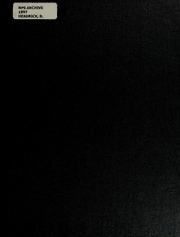
Analysis of Internal Wave induced mode coupling effects on the 1995 SWARM experiment acoustic transmissions. PDF
Preview Analysis of Internal Wave induced mode coupling effects on the 1995 SWARM experiment acoustic transmissions.
Analysis of Internal Wave Induced Mode Coupling Effects SWARM on The 1995 Experiment Acoustic Transmissions by Robert Hugh Headrick B.S. Chem. Eng., Oklahoma State University, 1983 M.S. Ocean Eng., M.I.T. / Woods Hole Oceanographic Institution, 1990 O.E. Ocean Eng., M.I.T. / Woods Hole Oceanographic Institution, 1990 Submitted in partial fulfillment ofthe Requirements for the degree of DOCTOR OF PHILOSOPHY in Ocean Engineering at the MASSACHUSETTS INSTITUTE OF TECHNOLOGY and the WOODS HOLE OCEANOGRAPHIC INSTITUTION (c) Robert Hugh Headrick, 1997. All rights reserved. The author hereby grants to the United States Government, MIT, and WHOI permission to reproduce and to distribute publicly paper and electronic copies of this thesis document in whole or in part. Analysis of Internal Wave Induced Mode Coupling Effects SWARM on The 1995 Experiment Acoustic Transmissions by Robert Hugh Headrick Submitted to the Massachusetts Institute of Technology/ Woods Hole Oceanographic Institution Joint Program in Oceanographic Engineering on April 28, 1997 in partial fulfillment of the Requirements for the Degree of Doctor of Philosophy in Oceanographic Engineering Abstract As part of the Shallow Water Acoustics in a Random Medium (SWARM) experiment [1], a sixteen element WHOI vertical line array (WVLA) was moored in 70 meters of water off the New Jersey coast. This array was sampled at 1395 Hz or higher for the seven days it was deployed. Tomography sources with carrier frequencies of 224 and 400 Hz were moored about 32 km shoreward, such that the acoustic path was anti-parallel to the primary propagation direction for shelf generated internal wave solitons. Two models for the propagation of normal modes through a 2-D waveg- uide with solitary internal wave (soliton) scattering included are developed to help in understanding the very complicated mode arrivals seen at the WVLA. The sim- plest model uses the Preisig and Duda sharp interface approximation for solitons, [2] allowing for rapid analysis of the effects of various numbers of solitons on mode ar- SWARM rival statistics. The second model, using thermistor string data to simulate the actual SWARM waveguides, is more realistic, but much slower. The analysis of WVLA the actual data yields spread, bias, wander, and intensity fluctuation signals that are modulated at tidal frequencies. The signals are consistent with predicted relationships to the internal wave distributions in the waveguides. Thesis Supervisor: Dr. James F. Lynch Associate Scientist Woods Hole Oceanographic Institution Acknowledgments I am indebted to the United States Navy for giving me the opportunity to once again pursue graduate studies at MIT and WHOI. The funds for my education were provided by the Office of Naval Research through an ONR Fellowship (MIT award SWARM 002734-001); thefunds for were also provided by the Officeof Naval Research ONR through Grant N00014-95-0051. I am very grateful to my thesis advisor Dr. James F. Lynch for his patience, guidance, and support. I thank him for allowing me to be a part of the SWARM experiment. I would like to thank all the fellow SWARM conspirators, without whom much of this research would not have been possible. A particular thanks goes to Arthur Newhall; his knowledge of computers and close proximity (seated adjacent to me for over two years) were of immeasurable worth. Thanks also goes to the rest of my thesis committee: Prof. Henrik Schmidt, Dr. Timothy Duda, and Dr. John Colosi. Their observations and comments were put to good use. Several "coupled-mode" discussions I had with Dr. Richard Evans were also very beneficial. I also thank Dr. Glen Gawarkiewicz for serving as Chairman of the Defense. I thank my wife, Carolyn, and our three children, Bobby, Paul, and Sarah, for their enduring love and support. Soli Deo Gloria Contents 1 Background 25 1.1 Solitons 25 1.2 Acoustic Impact of Solitons 28 1.2.1 Time Spreading 28 1.2.2 Attenuation 30 1.3 Outline of Thesis 31 2 Data Collection 33 2.1 Experiment Geometry 33 2.2 Source Signals 33 2.3 Receiving Array 34 2.4 Signal Isolation 36 2.4.1 Sequence Capture 36 2.4.2 Pulse Compression 37 Mode 3 Filtering 41 3.1 Normal Modes 41 3.2 Array Tilt 44 3.3 Mode Filtering 45 3.3.1 Errors from Array Tilt 45 3.3.2 Time Dependence of Filter Performance 47 5 3.3.3 Mode Filter Outputs 51 4 A Simple Scattering Model 57 4.1 Normal Mode Pulse Propagation 57 4.1.1 Total Field Summation 58 4.1.2 Step Summation 63 4.2 Incorporation of Field Measured SSPs 65 4.2.1 Validity of 400 Hz Narrowband Models for a Broadband Pulse 67 4.2.2 Adding Modal Attenuation 70 4.2.3 The Effects of Bottom Topography 73 4.3 Incorporation of a Background Internal Wave Spectrum 73 4.3.1 EOF Soundspeed Perturbation Modes 75 4.4 Fine Scale Coupled Mode Computations 76 4.5 Putting it All Together 79 5 Model Analysis 81 5.1 Monte Carlo Analysis of the SIA Model 81 5.1.1 Relevant Statistics 81 5.1.2 Simulation Parameters 84 5.2 Analysis of the "Propagated Thermistor String Model" 102 5.2.1 An Example Waveguide 102 5.2.2 Model Results 102 5.3 The Transition to Real Data 112 6 Analysis of Real Data 115 6.1 400 Hz Mode 1 Arrival Analysis 115 6.1.1 Peak Arrival Time 115 6.1.2 Arrival Spread 121 6.1.3 Peak Arrival Intensity 126 6.1.4 Higher Mode Statistics 129 6
